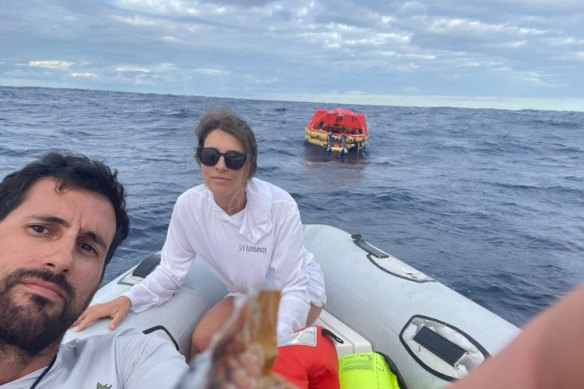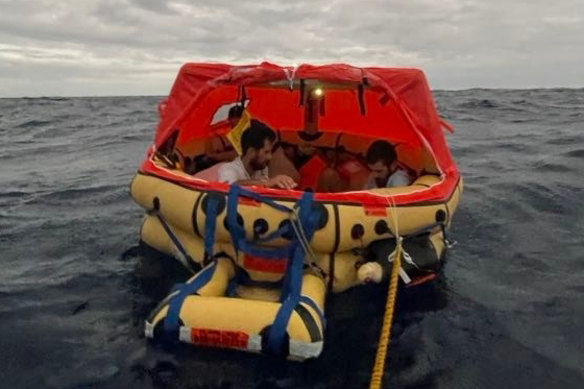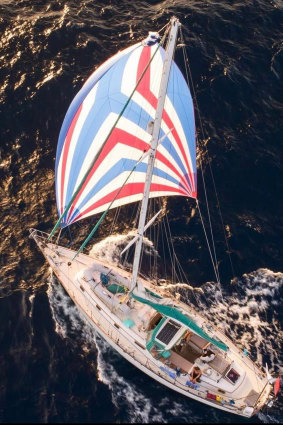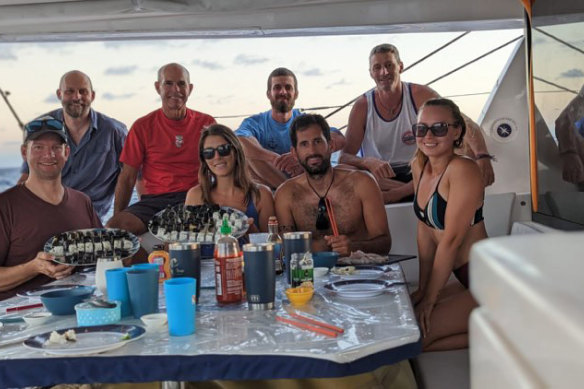This was published 1 year ago
‘We hit a whale and the ship went down’: Sailboat crew rescued in the Pacific
By Karen Schwartz
His circumstances sounded straight out of Moby Dick but Rick Rodriguez wasn’t kidding. In his first text messages from the life raft, he said he was in serious trouble.
“Tommy this is no joke,” he typed to his friend and fellow sailor Tommy Joyce. “We hit a whale and the ship went down.”

Rick Rodriguez takes a selfie of himself and Alana Litz adrift in the Pacific.Credit: Rick Rodriguez
“Tell as many boats as you can,” Rodriguez also urged. “Battery is dangerously low.”
On March 13, Rodriguez and three friends were 13 days into what was expected to be a three-week crossing from the Galápagos to French Polynesia on his 44-foot sailboat, Raindancer. Rodriguez was on watch, and he and the others were eating a vegetarian pizza for lunch around 1:30 pm. In an interview with The Washington Post later conducted via satellite phone, Rodriguez said the ship had good winds and was sailing at about 6 knots when he heard a terrific BANG!
“The second pizza had just come out of the oven, and I was dipping a slice into some ranch dressing,” he said. “The back half of the boat lifted violently upward and to starboard.”
The sinking itself took just 15 minutes, Rodriguez said. He and his friends managed to escape onto a lifeboat and a dinghy. The crew spent just 10 hours adrift, floating about nine miles before a civilian ship plucked them from the Pacific Ocean in a seamless predawn manoeuvre. A combination of experience, technology and luck contributed to a speedy rescue that separates the Raindancer from similar catastrophes.
“There was never really much fear that we were in danger,” Rodriguez said. “Everything was in control as much as it could be for a boat sinking.”
It wasn’t lost on Rodriguez that the story that inspired Herman Melville happened in the same region. The ship Essex was also heading west from the Galápagos when it was rammed by a sperm whale in 1820; leaving the captain and some crew to endure roughly three months and resort to cannibalism before being rescued.
There have been about 1200 reports of whales and boats colliding since a worldwide database launched in 2007, said Kate Wilson, a spokeswoman for the International Whaling Commission. Collisions that cause significant damage are rare, the US Coast Guard said, noting the last rescue attributed to damage from a whale was the sinking of a 40-foot J-Boat in 2009 off Baja California, with that crew rescued by Coast Guard helicopter.
Alana Litz was the first to see what she now thinks was a Bryde’s whale as long as the boat. “I saw a massive whale off the port aft side with its side fin up in the air,” Litz said.
Rodriguez looked to see it bleeding from the upper third of its body as it slipped below the water.

Rick Rodriguez and Simon Fischer in the life raft from the sunken Raindancer.Credit: Alana Litz
Bianca Brateanu was below cooking and got thrown in the collision. She rushed up to the deck while looking to the starboard and saw a whale with a small dorsal fin 30 to 40 feet off that side, leading the group to wonder if at least two whales were present.
Within five seconds of impact, an alarm went off indicating the bottom of the boat was filling with water, and Rodriguez could see it rushing in from the stern.
Water was already above the floor within minutes. Rodriguez made a mayday call on the VHF radio and set off the Emergency Position Indicating Radio Beacon (EPIRB). The distress signal was picked up by officials in Peru, who alerted the US Coast Guard District 11 in Alameda, California which is in charge of US vessels in the Pacific.
The crew launched the inflatable life raft, as well as the dinghy, then realised they needed to drop the sails so that line attaching the life raft didn’t snap as it got dragged behind still-moving Raindancer.
Rodriguez grabbed his snorkel gear and a tarp and jumped into the water to see if he could plug the holes, but it was futile. The area near the propeller shaft was badly punched in, he said.
Meanwhile, the others had gathered safety equipment, emergency gear and food. In addition to bottled water, they filled “water bottles, tea kettles and pots,” before the salt water rose above the sink, Rodriguez said.
“There was no emotion,” Rodriguez recalled. “While we were getting things done, we all had that feeling, ‘I can’t believe this is happening,’ but it didn’t keep us from doing what we needed to do and prepare ourselves to abandon ship.”
Rodriguez and Simon Fischer handed the items down to the women in the dinghy, but in the turmoil, they left a bag with their passports behind. They stepped into the water themselves just as the deck went under.

A picture of the Raindancer on a crossing from Panama to the Galapagos taken February 3. Credit: Rick Rodriguez
Rodriguez swam to the life raft, climbed in and looked back to see the last 10 feet of the mast sinking “at an unbelievable speed,” he said. As the Raindancer slipped away, he pulled a Leatherman from his pocket and cut the line that tethered the life raft to the boat after Litz noticed it was being pulled taut.
They escaped with enough water for about a week and with a device for catching rain, Rodriguez said. They had roughly three weeks worth of food, and a fishing pole.
The Raindancer “was well-equipped with safety equipment and multiple communication devices and had a trained crew to handle this open-ocean emergency until a rescue vessel arrived,” said Douglas Samp, US Coast Guard Pacific Area search and rescue program mManager. He cautioned that new technology should not replace the use of an EPIRB, which has its own batteries.
Indeed, the one issue the crew faced was battery power. Their Iridium Go, a satellite Wi-Fi hotspot, was charged to only 32 per cent (dropping to 18 per cent before the rescue.) The phone that pairs with it was at 40 per cent, and the external power bank was at 25 per cent.
Rodriguez sent his first message to Joyce, who was sailing a boat on the same route about 180 miles behind. His second was to his brother, Roger, in Miami. He repeated most of what he had messaged to Joyce, adding, “Tell mom it’s going to be okay.”
Rodriguez’s confidence was earned. A 31-year-old from Tavernier, Florida, he had spent about 10 years working as a professional yacht captain, mate and engineer. He bought the Raindancer in 2021 and lived on her, putting sweat equity into getting the boat, built in 1976, ready for his dream trip.
Both he and Brateanu, 25, from Newcastle, England, have mariner survival training. Litz, 32, from Comox, British Columbia, was formerly a firefighter in the Canadian military. Fischer, 25, of Marsberg, Germany, had the least experience, but “is a very levelheaded guy,” Rodriguez said.
Rodriguez gave detailed information on their location and asked his brother to send a message via WhatsApp to Joyce, who has a Starlink internet connection that he checks more frequently than his Iridium Go. Because of his low battery, he told his brother he was turning the unit off and would check it in two hours.
Rodriguez also activated a Globalstar SPOT tracker, which transmitted the position of the life raft every few minutes, and he broadcast a mayday call every hour using his VHF radio.
When he turned the Iridium Go back on at the scheduled time, there was a reply from Joyce: “We got you bud.”
As luck would have it, the Raindancer was sailing the same route as about two dozen boats participating in a round-the-world yachting rally called the World ARC. Boatwatch, a network of amateur radio operators that searches for people lost at sea, was also notified. And the urgent broadcast issued by the Coast Guard was answered by a commercial ship, Dong-A Maia, which said it was 90 miles to the south of Raindancer and was changing course.
“We have a bunch of boats coming. We got you brother,” Joyce typed.
“Can’t wait to see you guys,” Rodriguez replied.
Joyce told Rodriguez that the closest boat was “one day maximum.”
In fact, the closest boat was a 45-foot catamaran not in the rally. The Rolling Stones was only about 35 miles away. The captain, Geoff Stone, 42, of Muskego, Wisconsin, had the mayday relayed to him by a friend sailing about 500 miles away. He communicated with Joyce via WhatsApp and with the Peruvian coast guard using a satellite phone to say they were heading to the last known coordinates.

he crews of the Raindancer and the Rolling Stones used a timer on March 15 to take a group portrait using Geoff Stone’s phone. Credit: Geoff Stone
In the nine hours it took to reach the life raft, Stone told The Post, he and the other three men on his boat were apprehensive about how the rescue was going to work.
“The seas weren’t terrible but we’ve never done a search and rescue,” he said. He wasn’t sure whether they would be able to find the life raft without travelling back and forth.
He was surprised when Fischer spotted the Rolling Stones lights from about five miles away and made contact on the VHF radio.
Once it got closer, Rodriguez set off a parachute flare, then activated a personal beacon that transmits both GPS location and AIS (Automatic Identification System) to assist in the approach. Although the 820-foot Dong-A Maia, a Panamanian-flagged tanker, was standing by, it made more sense to be rescued by the smaller ship.
To board the Rolling Stones, the crew from the Raindancer transferred to the dinghy with a few essentials, then detached the life raft so it wouldn’t get caught in the boat’s propeller.
“We were 30 or 40 feet away when we started to make out each other’s figures. There was dead silence,” Rodriguez said. “They were curious what kind of emotional state we were in. We were curious who they were.”
“I yelled out howdy,” to break the ice, he explained.
One by one they jumped onto the transom. “All of a sudden us four were sitting in this new boat with four strangers,” Rodriguez said.
The hungry sailors were given fresh bread, then offered showers. The Rolling Stones crew gave their guests toothbrushes, deodorant and clothes. None even had shoes.
Rodriguez said he had tried not to think about losing his boat while the crisis was at hand. But, the first morning he woke up on Rolling Stones, it hit him. Not only had he lost his home and belongings, he felt like he’d lost “a good friend.”
“I’ve worked so hard to be here, and have been dreaming of making landfall at the Bay of Virgins in the Marquesas on my own boat for about 10 years. And 1,000 nautical miles short my boat sinks,” Rodriguez said.
The Rolling Stones is expected to arrive in French Polynesia on Wednesday, and Rodriguez is glad that he’s onboard.
“I feel very lucky, and grateful, that we were rescued so quickly,” he said. “We were in the right place at the right time to go down.”
The Washington Post